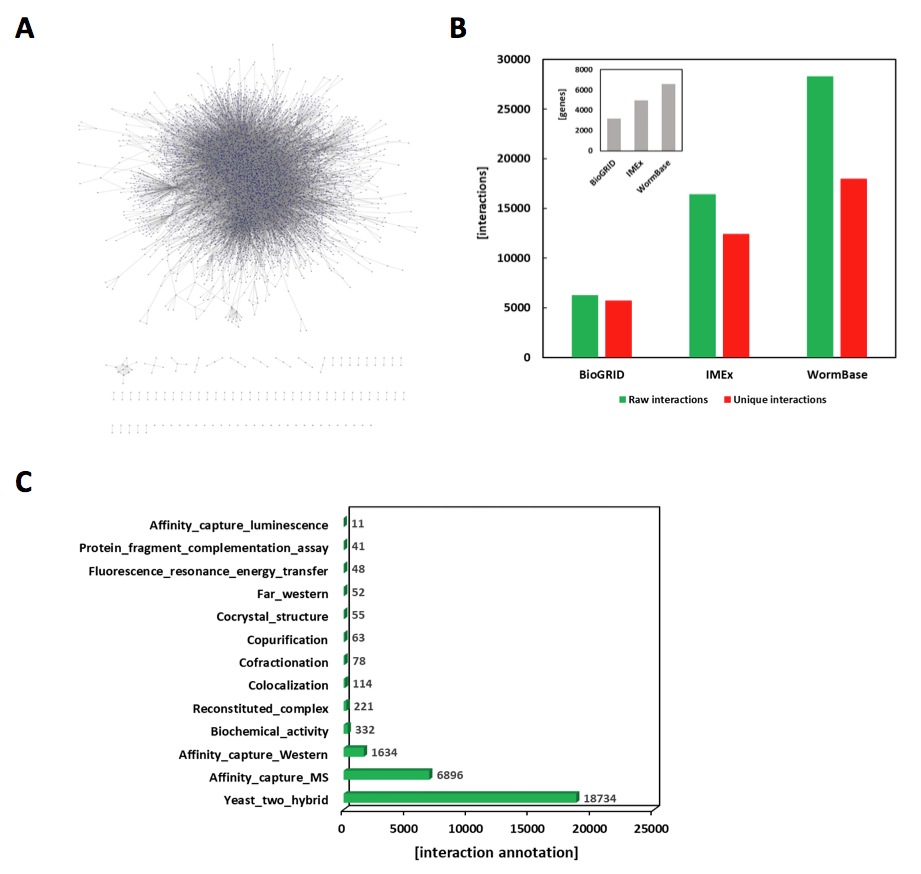Informatics and Bio-computing Platform, Ontario Institute for Cancer Research, Toronto, ON M5G0A3, Canada
Description
Protein interaction is an important data type to understand the biological function of proteins involved in the interaction, and helps researchers to deduce the biological nature of unknown proteins from the well-characterized functions of their interaction partners. High-throughput studies, coupled with the aggregation of individual experiments, provides a global ‘snapshot’ of the protein interactions occurring at all levels of biological processes or circumstances. This snapshot of the interaction network, the interactome, is important to understand the overall events up to the level of comparison between species or pathway simulation, or to find new factors yet undefined in the processes, or to add details to the biological processes and pathways.
As of September 2018, WormBase (www.wormbase.org) (Lee et al. 2018) contains 28,279 physical protein-protein interactions for the roundworm Caenorhabditis elegans. Among these, 1500 protein-protein interactions have been curated by BioGRID as a collaboration with WormBase. Within the data set, 17,990 protein-protein interactions are unique, and 6,079 unique genes are involved in these interactions. In order to visualize the overall interaction map, a network diagram for all the unique interactions was generated by using the ‘Cytoscape’ program, version 3.6.1 (Shannon et al. 2003) (Figure 1A). These numbers represent a 108% increase in the number of interaction annotations since last year, 2017. These interaction data were curated from 1,251 peer-reviewed papers, which were selected from the literature by ‘Textpresso Central’ using automatic SVM (Support Vector Machine)-based text mining approaches (Fang et al. 2012; Müller et al. 2018) and manual verification. Compared to other databases providing C. elegans protein-protein interaction, WormBase now presents the largest data set, which has 1.72-fold more interaction annotations than IMEx (Orchard et al. 2012) and 4.51-fold more than BioGRID (Chatr-Aryamontri et al. 2017) (Figure 1B). Most significantly, WormBase now houses the complete protein interaction data from almost all of the C. elegans literature published from 1993 to 2018. The data sets presented at IMEx and BioGRID are annotated from 253 and 174 papers, respectively. All the physical interaction data in WormBase are supported by experimental evidence from original research papers. The statistics of the detection methods used as experimental evidence are shown in Figure 1C. The majority of the interaction data came from high throughput analysis such as large-scale yeast two-hybrid assays or mass-spectrometry, however, a significant portion of the data (13.1%) are supported by more direct detection methods using small-scale, low throughput methods such as co-immunoprecipitation or co-crystallography (Figure 1C).
In WormBase, protein-protein interaction data can be found as a subclass of physical interaction data in the ‘Interactions widget’ on the gene report page. The Interactions widget provides all types of interaction data related to the gene of interest, such as physical, genetic, regulatory, and predicted interactions. All the interaction data are represented together in a graph created with ‘Cytoscape.js’ and a table. In the table, the gene names of interaction partners (bait-target) in the interaction are displayed along with the publication. The interaction details including the detection method are also captured in the summary and the remark field in the Interactions page. Users can query the data by using the search bar on the WormBase front page or download all the available data files from the WormBase FTP site (ftp://ftp.wormbase.org/pub/wormbase/releases/current-production-release/species/c_elegans/PRJNA13758/annotation/c_elegans.PRJNA13758.WSXXX.interactions.txt.gz, where WSXXX is the database version release, like “WS267”).
All the interaction data in WormBase will be available soon at the new information resource for multiple model organisms, the Alliance of Genome Resources (https://www.alliancegenome.org/). This site will integrate all the interaction data from human and from model organisms C. elegans, budding yeast (Saccharomyces cerevisiae), fruit fly (Drosophila melanogaster), zebrafish (Danio rerio), mouse (Mus musculus) and rat (Rattus norvegicus). Integrated views of interaction data from diverse model organisms will be extremely helpful to build interaction databases for species-to-species comparison, and to establish a disease model quickly based on the database. For the most efficient analysis of the interaction data in WormBase, we are now working on developing a new ‘Venn diagram tool’ and integrating the ‘Gene Set Enrichment Analysis tool’ (https://wormbase.org/tools/enrichment/tea/tea.cgi) into the Interactions widget. We will continue to curate other types of macro-molecular interactions including protein-DNA, protein-RNA and RNA-RNA interactions, as well as newly reported protein-protein interaction data to serve our research community.
Reagents
All the interactions data are available at the WormBase FTP site(ftp://ftp.wormbase.org/pub/wormbase/releases/current-production-release/species/c_elegans/PRJNA13758/annotation/c_elegans.PRJNA13758.WSXXX.interactions.txt.gz, where WSXXX is the database version release, like “WS267”).
References
Funding
Supported by NIH U24 HG002223 (to PWS)
Reviewed By
Weiwei ZhongHistory
Received: October 9, 2018Accepted: November 21, 2018
Published: November 26, 2018
Copyright
© 2018 by the authors. This is an open-access article distributed under the terms of the Creative Commons Attribution 4.0 International (CC BY 4.0) License, which permits unrestricted use, distribution, and reproduction in any medium, provided the original author and source are credited.Citation
Cho, J; Grove, CA; Van Auken, K; Chan, J; Gao, S; Sternberg, PW (2018). 2018 Update on Protein-Protein Interaction Data in WormBase. microPublication Biology. 10.17912/micropub.biology.000074.Download: RIS BibTeX




